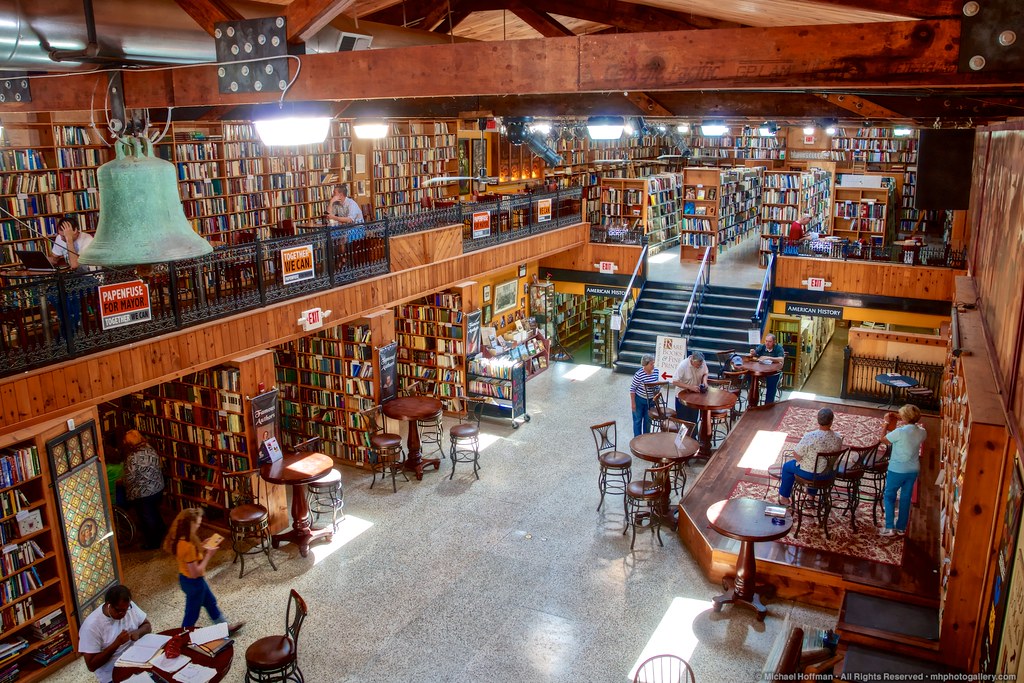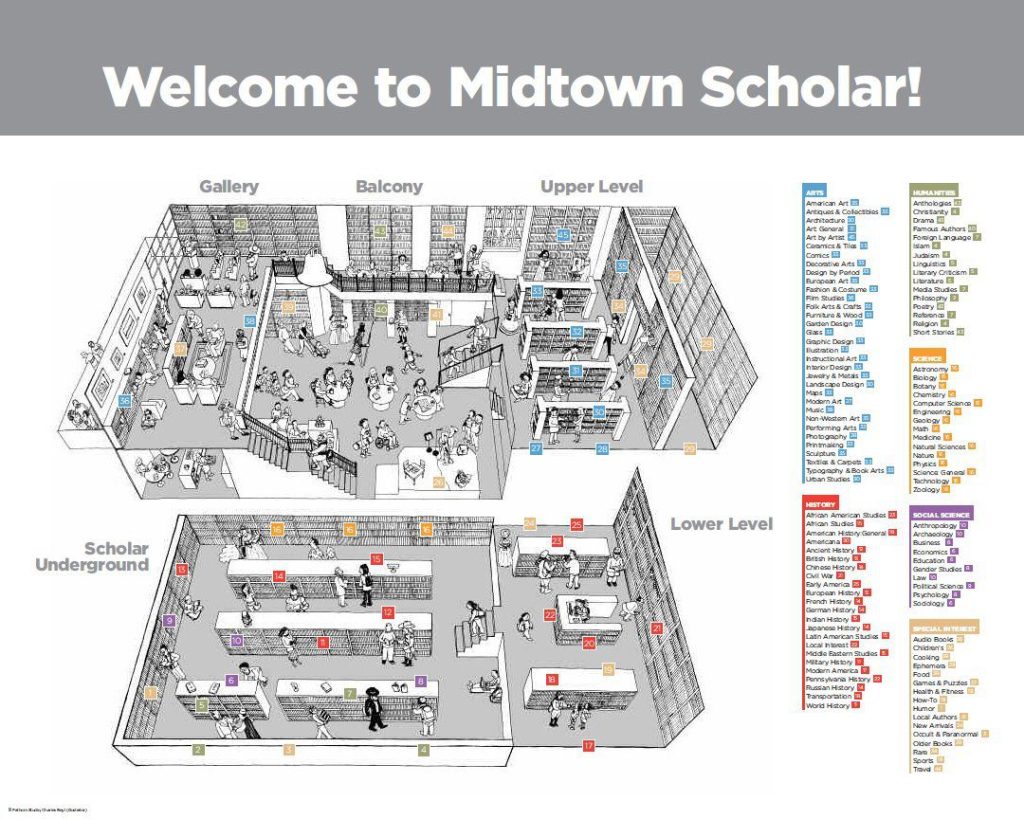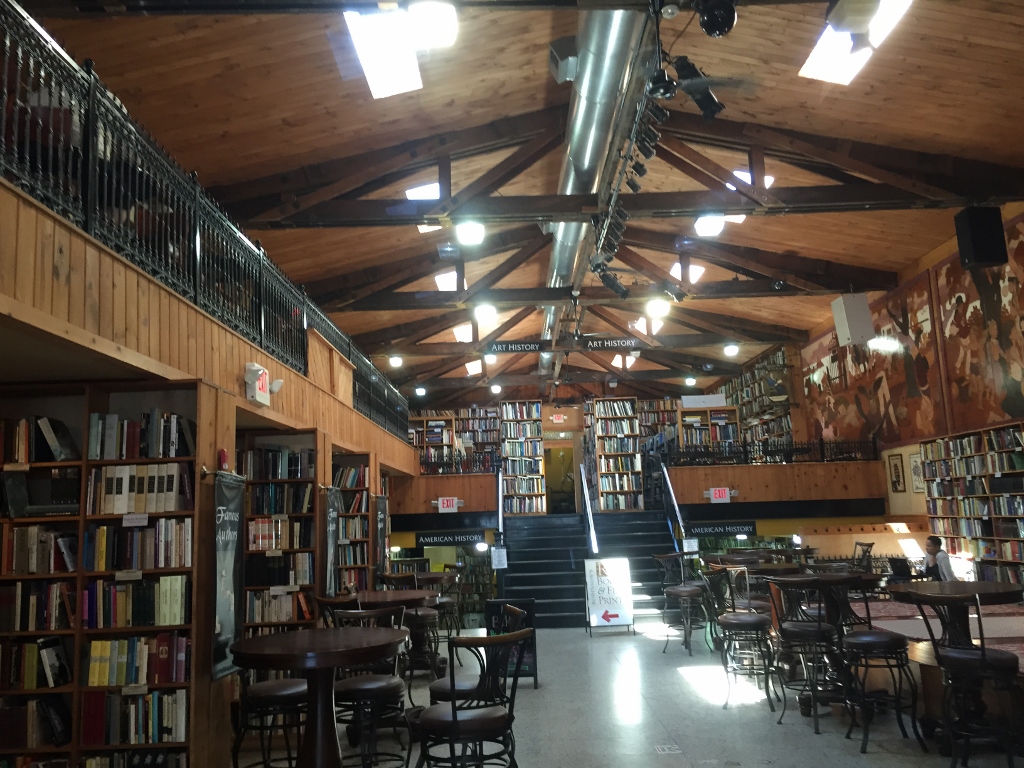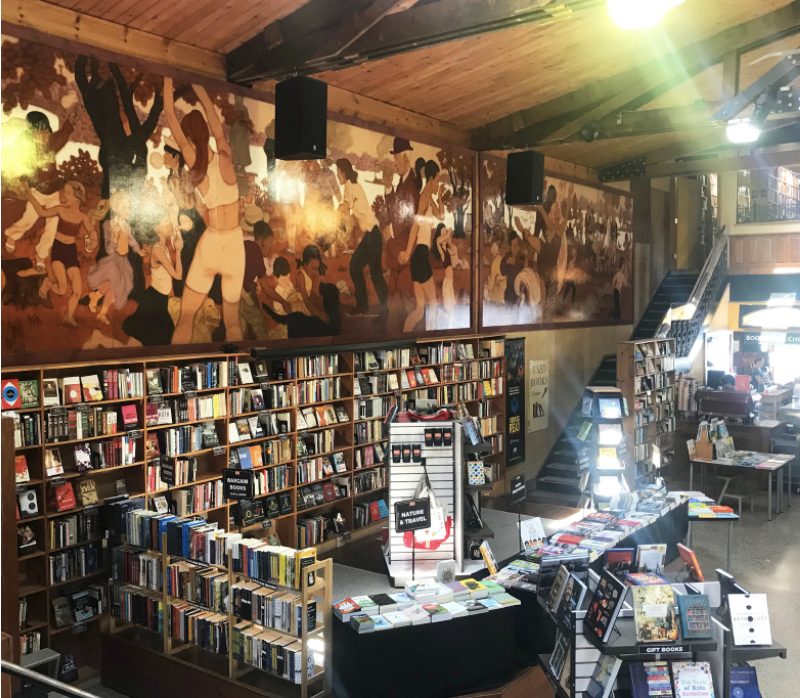Midtown Scholar’s Menagerie: Everything, Everywhere
Although based in the renovated remnants of a historic movie theater, and originally beginning as an online storefront, the Midtown Scholar as it presently stands can best be described as a haven for bookworms and casual readers alike, feeling like a lodge of sorts, where its shelves are stocked with a vastly diverse array of literature, so much so that the average customer may not know where to begin.

As described by the owners, Eric Papenfuse and Catherine Lawrence in an interview on their YouTube channel, every aspect of the Midtown Scholar’s structure from the ground up was deliberate– each panel, light, even the newly furnished stage in the center of the establishment were all placed there with the larger design in mind. The space exists to connect the consumer with one another, and with Midtown Scholar’s collection of texts, which sets itself apart from other independent bookstores through its scale and scope. For all intents and purposes, the Scholar could serve as a library, its collection of 200,000 texts rivaling most comparable institutions; what differs from the rest, however, is the presentation.
An excerpt from the reading “On Collecting Art and Culture” by James Clifford highlights a similar sentiment, as he describes ethnography as a form of collecting, relating it to the contemporary Western notion of “collection,” being that whatever items a collection consists of, they will fade without proper care, Clifford describing it as a “rescue of phenomena from inevitable historical decay or loss” (231). In this sense, the Midtown Scholar has an incredibly unique definition of collection, having it range dramatically in genre. Their collection is free-flowing and rapidly changes, and Papenfuse describes their desire to stock five unique titles over five copies of one in the same aforementioned interview, highlighting their sentiment towards collection. A diagram showing the layout and a full breakdown of all the genres and categories present in the store can be found below.

Aside from the over 200,000 titles housed in the Midtown Scholar, they have two cafes, an art gallery, and a stage at the center of the establishment that serves as a platform for authors, speakers, and artists to perform for the community; that, at its core, is what the Midtown Scholar seeks to engage with through every facet of its construction: the community– to foster a warm, thoughtful, ever-changing space that has something for everyone. It’s difficult to nail down precisely what “type” of bookstore the Scholar is, seeing as its genres range from Pennsylvanian historical accounts, to jewelry and textiles, even having a full catalog of texts on social sciences, the Scholar holds true to its namesake, baring a collection that would inspire envy in any academic.
I feel as though the two cafes located within serve as a microcosm for the overall feel of the bookstore. This too is difficult to articulate as “feel” isn’t all that descriptive of a term, but it’s essential to understand that this idea seeps from the very cracks of the foundation, as if the bookstore itself has a discernible personality.


To elaborate, the Midtown Scholar is an inherently social space, but the average consumer may not immediately jump at this opportunity, so they head to the fringes where both cafes are located. Upon my visit to the store, most people were centralized around these places– reading, discussing, observing– before that same cafe broke them out of their shells, prompting a sort of adventure through the self-described “labyrinthian” layout by Catherine Lawrence.
This term aptly describes the spiraling layout of the Midtown Scholar, composed of four floors with dramatically different subjects on each, allowing the appeal of the texts themselves to draw readers in and guide them on their path through the store. When they purchased the property, owners Papenfuse and Lawrence connected the basements of the two, adding a subterranean level to the store entirely of their own creation. It’s often said about mesmerizing places such as this, but I genuinely felt as though I could get lost within the establishment. When I visited the bookstore, one of the first things I noticed was how the texts were arranged in a near-overwhelming manner; shelves that tower over the consumer are what compose a majority of the store.

Specifically, those shelves and the books contained on them reminded me of an excerpt from Lydia Pyne’s Bookshelf, where she describes the relation between a collection and how its displayed on the shelf, saying “In other words, how books are cataloged, shelved, and displayed shows a certain worldview and a particular system of thinking—aesthetic, pragmatic, categorical, or out-and-out haphazard, even” (33). The way Midtown Scholar views its collection is as an amalgamation of knowledge, and this is reflected in the broadness of what’s contained on the shelves. As stated earlier, it’s difficult to nail down what type of bookstore the Scholar is as it is such a wide-spanning store, but the message spoken through the shelves are clear: the sky’s the limit.
Despite how initially chaotic things may seem within the Scholar, everything is painstakingly organized and cataloged, which is worthy of admiration when one knows the extent of their collection. I’d like to place special emphasis on the upper level of the store, where the gallery, humanities, arts, and ephemera sections are located, among much more.
While this is by no means the most “important” area of the store, any of which can be argued to be, I feel this is the best reflection of the beliefs of the owner on the design of their store. The shelves on this floor are as broad as the rest in the establishment, but they incorporate their dedication to the arts and humanities, having a balcony to overview shows, a gallery with work from local artists, and the upper level is dedicated to texts discussing arts and cultural interests.
The lighting and woodwork throughout the entire store is worthy of note, but it feels more intimate on the upper level due to the small space, soft lights shining on specific paintings and books; the grain of the wood making the upper level seem like a cabin, quaint and cozy, where one can take a seat on the chairs and open a text they’re interested in while observing the art.
Overall, the layout of Midtown Scholar encourages the consumer to choose their own experience in the depth of what they offer, carpe diem if you will. The warm and welcoming design, community-driven layout, and intentionality of each detail lends this bookstore an indescribable uniqueness which attracts those from all walks of life to engage with literature in this manner. Regardless of your age, identity, or level of education, Midtown Scholar goes above and beyond in fostering a welcoming environment, despite how overwhelming it may feel when first entering.
Texts Cited
Clifford, James. “On Collecting Art and Culture.” The Predicament of Culture: Twentieth-Century Ethnography, Literature, and Art, Harvard University Press, Cambridge, MA, 2002, pp. 212–249
Pyne, Lydia. Bookshelf. Bloomsbury Academic, 2019.
Floorplans Used
https://www.facebook.com/MidtownScholar/photos/a.10150580590017724/10150580597522724/?type=3&theater (Full store map)
Floorplan designed by author.

0 Comments